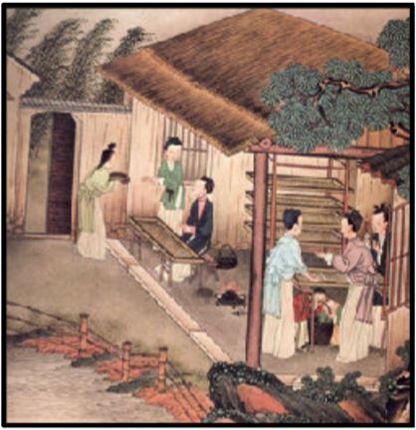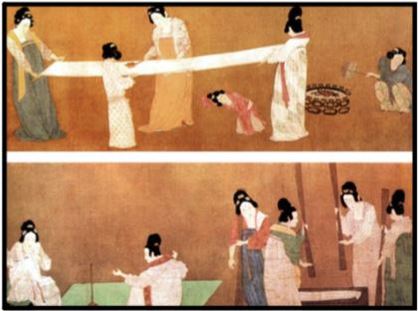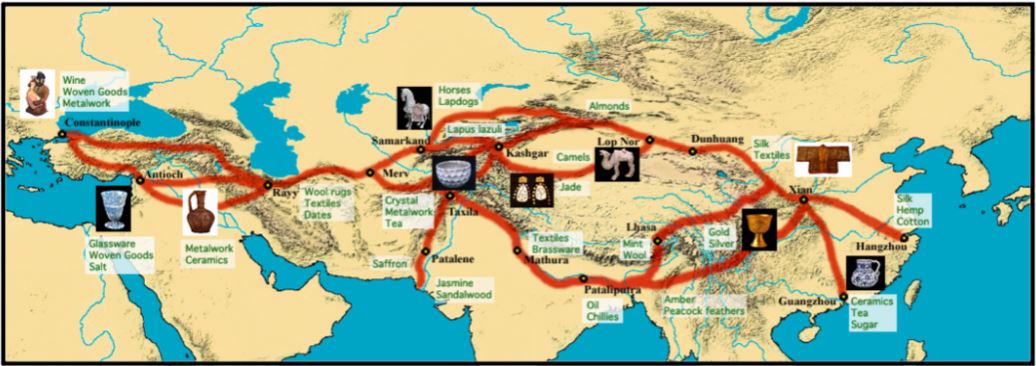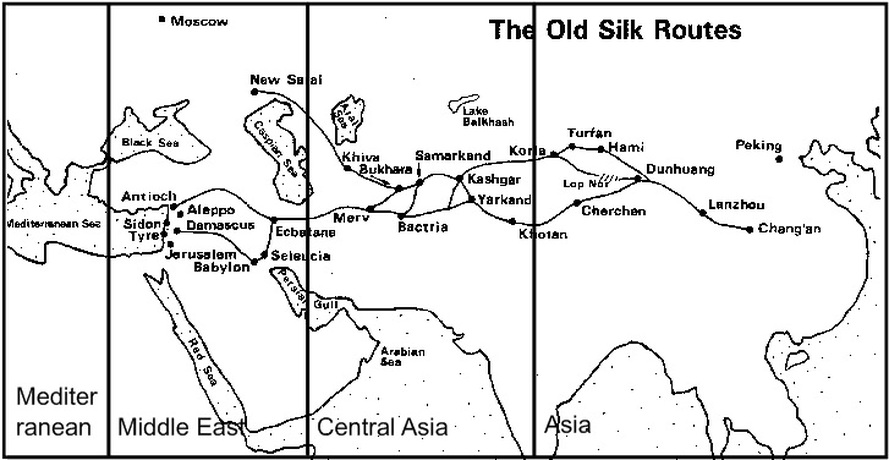China Silk Road Activity
Discovering Your Routes
 Originally, silk worm farming was restricted to women and it was the women who were responsible for the growing, harvesting and weaving.
Originally, silk worm farming was restricted to women and it was the women who were responsible for the growing, harvesting and weaving.
History of Silk: The earliest evidence of silk was found at the sites of Yang-shao culture along the banks of the Huang He River in Northern China. The Yang-shao, having settled along the Huang He over 10,000 years ago is one of the earliest Chinese civilizations. It was at one of the Yang-shao sites where a silk cocoon was found cut in half by a sharp knife, dating back to between 4000 and 3000 BCE. The species of the cocoon was identified as that of the domesticated silkworm. Fragments of a primitive loom have been found and dated to the same time period. That means that the Chinese have been weaving silk for around 6000 years.
Chinese traditions support the archaeological evidence. The writings of Confucius and Chinese folklore recount that in the 27th century BCE a silk worm's cocoon fell into the tea cup of the empress Leizu. While removing it from her drink, the cocoon began to unravel, and the 14 year old princess noticed that the silk was one, very long unbroken thread. According to the tale, Leizu then had the idea to weave it. On the recommendation of her husband, the Yellow Emperor, Leizu observed the life of the silk worm and instructed her entourage in the art of raising silk worms. The domestication of silkworms is called sericulture. From that point on, the girl became the goddess of silk in Chinese mythology.
Chinese traditions support the archaeological evidence. The writings of Confucius and Chinese folklore recount that in the 27th century BCE a silk worm's cocoon fell into the tea cup of the empress Leizu. While removing it from her drink, the cocoon began to unravel, and the 14 year old princess noticed that the silk was one, very long unbroken thread. According to the tale, Leizu then had the idea to weave it. On the recommendation of her husband, the Yellow Emperor, Leizu observed the life of the silk worm and instructed her entourage in the art of raising silk worms. The domestication of silkworms is called sericulture. From that point on, the girl became the goddess of silk in Chinese mythology.

Silk became a precious commodity highly sought by other countries at a very early time, and it is believed that the silk trade was actually started before the Silk Road was officially opened in the second century BCE. References to silk appear during Biblical times. An Egyptian female mummy with silk has been discovered in the village of Deir el Medina near Thebes and the Valley of the Kings that dates to 1070 BCE. So far, that is the earliest evidence of the silk trade. During the second century BCE, the Han emperor, Wu Di sent ambassadors as far west as Persia and Mesopotamia bearing gifts including silks. From that point on, silk was used by the Persian court. Alexander the Great encountered silk when he conquered the Persian empire and its king, Darius III, in the 4th century BCE.
Even though silk spread rapidly across Eurasia, its production remained exclusively with China for thousands of years. Silk eventually left China in the hair of a princess promised to a prince of Khotan. This probably occurred in the early 5th century CE. The princess, refusing to go without the fabric she loved, finally broke the imperial ban on silk worm exportation.
Even though silk spread rapidly across Eurasia, its production remained exclusively with China for thousands of years. Silk eventually left China in the hair of a princess promised to a prince of Khotan. This probably occurred in the early 5th century CE. The princess, refusing to go without the fabric she loved, finally broke the imperial ban on silk worm exportation.
Trading Places
Mapping the Silk Road
1) For this activity, you will work in a group to research goods traded along the Silk Road. Each group member will be responsible for researching one or more products.
The products to choose from are: silk, wine, paper, camels, porcelain, spices, tapestries & carpets, wine, perfume, tea, gold & silver, ivory, horses, furs, jade, Buddhism, and Islam.
2) Each group must research 6 items. You must find the following information for each product:
3) Next, on the map provided, mark the origin of each product as 'Point A" and the destination as "point B."
1) For this activity, you will work in a group to research goods traded along the Silk Road. Each group member will be responsible for researching one or more products.
The products to choose from are: silk, wine, paper, camels, porcelain, spices, tapestries & carpets, wine, perfume, tea, gold & silver, ivory, horses, furs, jade, Buddhism, and Islam.
2) Each group must research 6 items. You must find the following information for each product:
- Region of origin. That is, Where did the product begin its journey along the Silk Road
- Where the product(s) would have traveled on the Silk Road. From their point of origin, what route would the product have traveled.
3) Next, on the map provided, mark the origin of each product as 'Point A" and the destination as "point B."
- Use colored pencils to connect your points, thereby creating a map of trade routes for specific trade goods.
- Be sure to create a legend on your map that clearly identifies each good's trade route. Each group member needs to fill out their own map!


